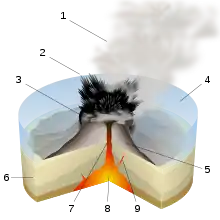Surtseyan eruption
A Surtseyan eruption is a type of volcanic eruption that takes place in shallow seas or lakes. It is named after the island of Surtsey off the southern coast of Iceland.[1]

Surtsey was the most famous example of a Surtseyan eruption.

Surtseyan eruption: 1 water vapor cloud, 2 cypressoid ash jet, 3 crater, 4 water, 5 layers of lava and ash, 6 stratum, 7 magma conduit, 8 magma chamber, 9 dike
These eruptions are commonly phreatomagmatic eruptions, representing violent explosions caused by rising basaltic or andesitic magma coming into contact with abundant, shallow groundwater or surface water. Tuff rings, pyroclastic cones of primarily ash, are built by explosive disruption of rapidly cooled magma.
Characteristics
Although similar in nature to phreatomagmatic eruptions, there are several specific characteristics:[2]
- Physical nature of magma: viscous; basaltic.
- Character of explosive activity: violent ejection of solid, warm fragments of new magma; continuous or rhythmic explosions; base surges.
- Nature of effusive activity: short, locally pillowed, lava flows; lavas may be rare.
- Nature of dominant ejecta: lithic, blocks and ash; often accretionary lapilli; spatter, fusiform bombs and lapilli absent.
- Structures built around vent: tuff rings
Examples of Surtseyan eruptions
- Bogoslof Island - Alaska, United States, 1796
- Fire Island - Alaska, United States, 1796
- Graham Island - Sicily, Italy, 1831[3]
- Anak Krakatau - Sunda Strait, Indonesia, 1927–1930 (with smaller eruptions continuing today) - further Surtseyan eruptions took place following the December 2018 eruption which left large sections of the volcano underwater
- Shōwa Iōjima - Iōjima, Kagoshima, Japan, 1934
- Capelinhos - Faial Island, Azores, 1957–1958
- Surtsey - Iceland, 1963
- Jólnir - Iceland, 1966
- Taal Volcano - Batangas, The Philippines (last erupted 2020)
- Zubair Group - Yemen, 2011–2012
- El Hierro - Canary Islands, 2011–2012 (see 2011–12 El Hierro eruption)
References
- Island Building Events
- Surtseyan Eruptions Archived 2010-04-29 at the Wayback Machine
- "Ferdinandea". INGVvulcani (in Italian). Retrieved 2020-11-30.
This article is issued from Wikipedia. The text is licensed under Creative Commons - Attribution - Sharealike. Additional terms may apply for the media files.